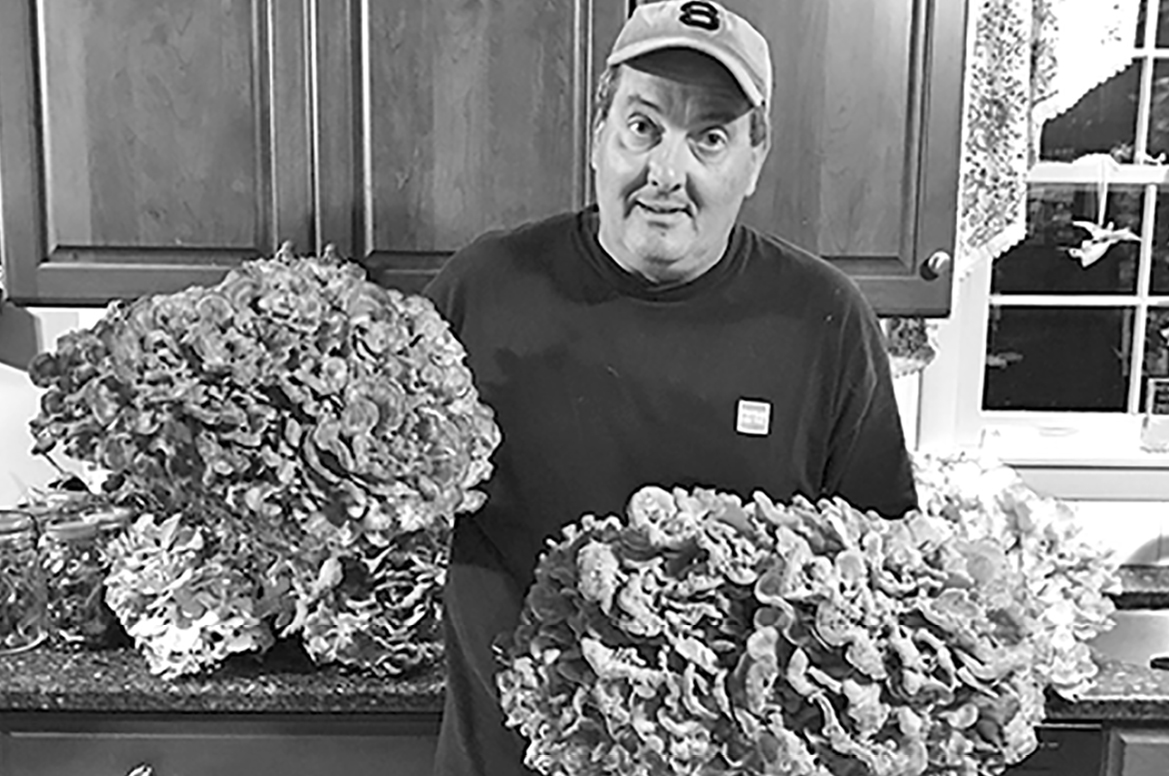
Photo by Lisa Shelanskas
John Shelanskas displays the impressive harvest of one of his local mushroom forays. He keeps his locations secret.
Some days my inner Neanderthal takes over and when I finish doing a cave painting and gnawing on some bones, I hit the trail to forage. Like every kid in New England, I spent summers chewing on stems of grass, ruminating on dandelion leaves and picking blackberries straight from the vine. As a result, my stomach was probably filled with dirt. Actually, there are folks out there that crave dirt, a condition known as geophagia. But for me, dirt was more of a byproduct rather than something I was actually seeking out. So, regardless, we grew up consuming dirt and washing it down with swamp water, and naturally- foraged vegetation provides an opportunity to continue this trend as an adult. There are lots of edibles and I often gather wild strawberries, Indian cucumbers and Asiatic dayflowers to supplement my salad.
This fall, I have seen lots of mushrooms and been tempted around every corner, but leave the gathering of them to the experts. This was further confirmed by a friend of mine who recently ate a bad mushroom. She became confused, had trouble keeping her saliva in check, and encountered stomach issues which were capped off by a visit to the ER. So I don’t take my chances with mushrooms. Local foragers, echo this sentiment.
John Shelanskas, under the tutelage of Laurie Tavino, learned to identify local edible mushrooms. Like any dedicated ’shroomer, he enjoys the thrill of the hunt and never reveals where he finds his prize. In fact, from a tender age John developed caginess and a poker face which helps to shroud his harvest in mystery. This year his Hen of the Wood specimens each weighed over 15 lbs. At home, he dehydrates and later savors these textured giants, reminiscent of portabellos. Whether you harvest or not, there is a lot to love about these enigmas of the natural world. Mushrooms are the fruiting body of fungi that appear above ground.
During my college days, we discussed mushrooms in my Botany classes. So when I wasn’t peering out the window or making goo-goo eyes at my dreamy lab partner, I was learning about mushrooms and fungi. I even had some adventurous friends who took their botany studies to another level by delving into the world of psychedelic mushrooms. They claimed it was strictly to keep their GPA up. They seemed very hip and really held court around our lab tables. As the years have passed, my appreciation for mushrooms and fungi has only grown. They have no roots, stems or leaves and grow from tiny spores. Ecologically, they are powerhouses, breaking down plant matter and speeding up the circle of life. There is more than meets the eye, and beneath the soil they have thread like strands of mycelium which can be massive and ancient, covering acres and living for hundreds, perhaps thousands of years. I love the thought of this massive structure lying beneath our feet as we walk the paths where mushrooms grow. It makes putting one foot in front of the other way more interesting as I contemplate the subterranean world.
About this time of year, the mushrooms are no longer pushing out of the earth or out of the crevices of logs. Fortunately, there is a good supply of bracket fungus which clings to trees year round and grows more slowly, adding a tiny bit of growth each year. It’s sturdy and beautiful and looks like modern art adorning the trees on the trail. So, on these dreary November days when the woods fall silent, the bracket fungus awaits to tempt us out of our Barca lounger and into the woods.